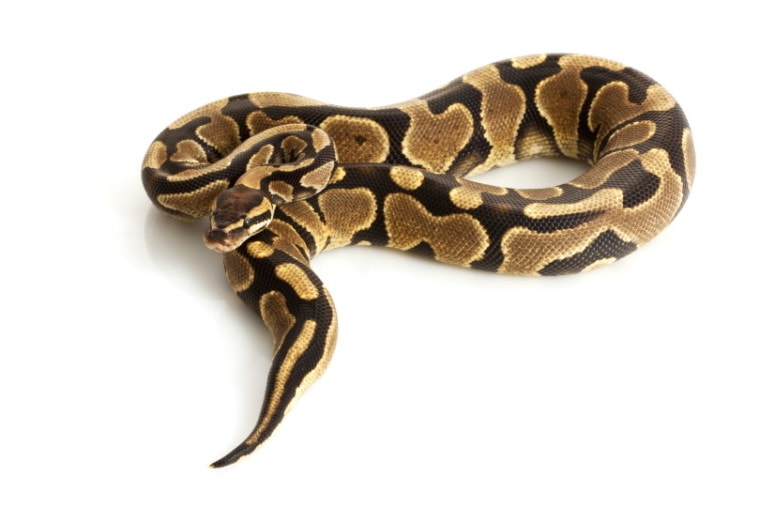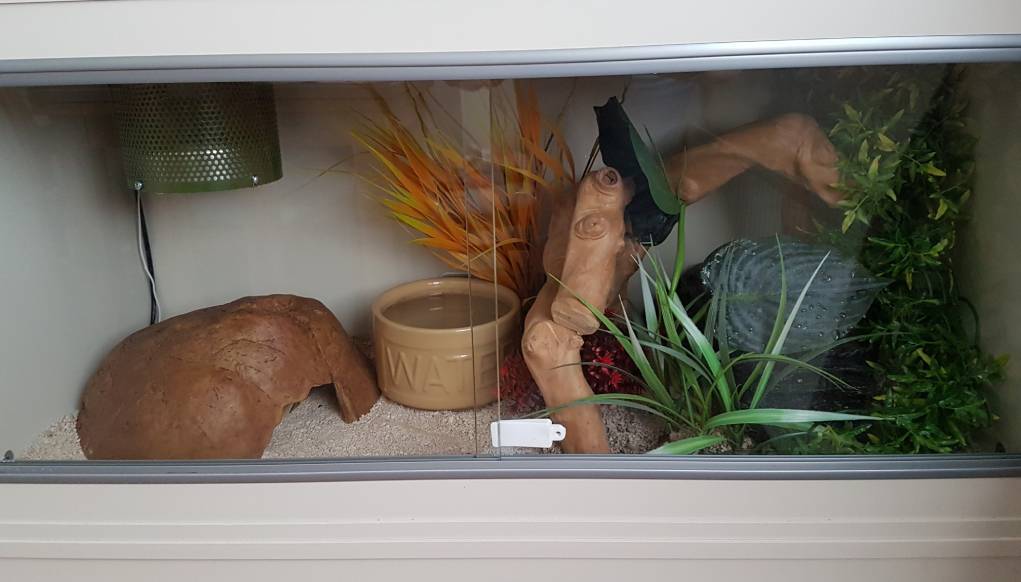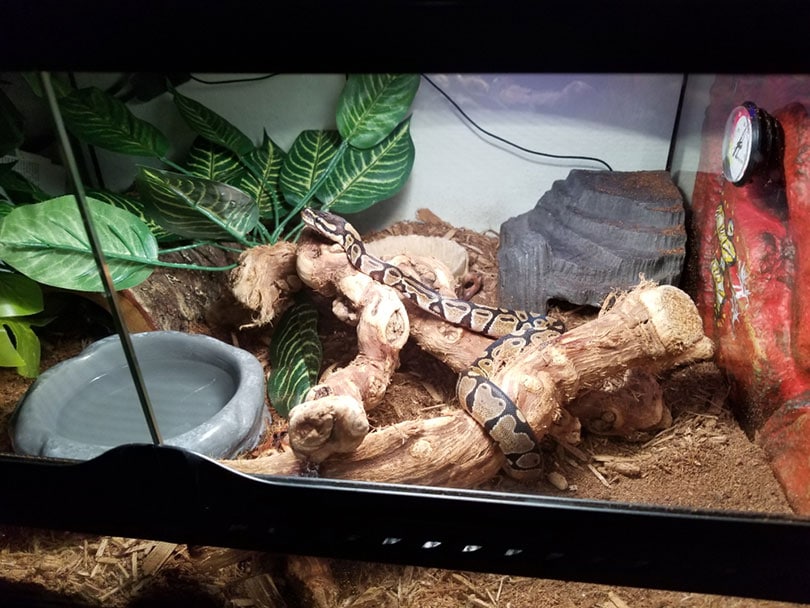
Ball pythons are some of the most popular snakes around. They are relatively easy to breed in captivity and quite docile. This ease of breeding has allowed many different morphs to pop up over the years.
A morph is a particular coloration that is not usually found in nature. These colors are natural in that the snakes naturally have the gene. It was either there the whole time and hidden amongst wild snakes or the result of a random mutation. Often, it is impossible to tell.
Most morphs are recessive, like the yellow belly morph. Therefore, they tend to be quite rare. It takes two copies of the gene for the coloration to appear in a snake.
The yellow belly morph was first produced in 1999 by Amir Soleymani. He didn’t technically breed the first yellow belly ball python morph. Instead, he discovered this odd snake at a show and thought it was something special. He proved the coloration to be genetic in 2001.
Beyond the color difference, these snakes are very similar to other ball pythons. They have the same temperaments and behaviors. Overall, these tend to be very laidback snakes, which makes them great for beginners.
 Quick Facts about the Yellow Belly Ball Python Morph
Quick Facts about the Yellow Belly Ball Python Morph

| Species Name: | Ball python |
| Common Name: | Python regius |
| Care Level: | Easy |
| Lifespan: | 30 years |
| Adult Size: | 4 to 5 feet |
| Diet: | Rodents |
| Minimum Tank Size: | 36” x 18” x 12” |
| Temperature & Humidity: | 75-85 degrees Fahrenheit |
Do Yellow Belly Ball Python Morphs Make Good Pets?
Ball pythons are very easy going snakes. They are docile and tend to be more laid back than other species. Because of this, they are often recommended for beginners. They are also relatively popular and easy to find, though this cannot be said for the yellow belly morph in particular.
If you’re looking for a snake that’s easy to handle and take care of, the ball python is probably your best option. With a bit of handling, they become very comfortable around people and easily accept contact. They don’t have any special needs beyond what a typical snake needs.
Appearance
The most noticeable feature of the yellow belly ball python is its rich coloration. Their belly is clear, and they have checkered patterns across the edges of their belly. The super form is named “ivory” and is usually considered a different morph altogether, though it does use the same genes.
The exact coloration will vary from snake to snake. Some do not appear to be yellow belly morphs at all, while it is unmistakable in others. It is difficult to predict which snakes will look the most obvious.
Beyond this coloration difference, this snake is similar to other ball pythons. It can reach a maximum adult length of 6 feet. Males are usually smaller by a bit. All fully grown snakes are around 3.5 pounds. The exact average size of a male is 3.44 pounds, while females are 3.6 pounds. There will be some variants between individuals.
These snakes are relatively stocky with small heads. Their scales are smooth.
 How to Take Care of Yellow Belly Ball Pythons
How to Take Care of Yellow Belly Ball Pythons
Habitat, Tank Conditions & Setup
Tank
Ball python enclosures can be pretty straightforward. They don’t require much. A 36” x 18” x 12” is likely large enough for an adult ball python. They don’t move around often and prefer smaller spaces, as they make them feel secure.
The top should preferably not be a screen, as this can make it difficult to maintain humidity.
Spot clean the tank as necessary. Be sure to add a hide box, as these docile snakes will often enjoy hiding for much of the time. Some owners recommend two different hide boxes, especially if your tank is more prominent.

Lighting
Ball pythons do not require any specific lighting. The light around their tank should follow the usual day-night cycle. In other words, don’t leave the light on all night.
Heating (Temperature & Humidity)
Their tank should have a temperature gradient so that they can control their temperature. The cooler side can get as low as 75 degrees F, but it should not drop beyond this. Their basking temperature should be around 88 to 96 degrees F, while the ambient temperature can be around 78 degrees F. It is essential to monitor the temperature with a thermometer.
You can use under-cage heating pads, tape, ceramic heat emitters, or basking bulbs. All heating options are available except heat rocks, as this can cause uneven heating and burns.
Substrate
There are a lot of options you can use for your snake’s substrate. Newspapers and paper towels are an easy option, as they can be spot cleaned quickly. Cypress mulch and orchid bark are two more good options, as they help keep humidity high. However, they are more expensive and more challenging to keep clean.
You shouldn’t use a substrate that contains any oils, such as cedar. These can harm your snake.

Tank Recommendations
| Tank Type: | 36” x 18” x 12” clear container |
| Lighting: | N/A |
| Heating: | Anything but a heating rock |
| Best Substrate: | Newspaper, paper towels, cypress mulch, orchid bark |
 Feeding Your Yellow Belly Ball Python
Feeding Your Yellow Belly Ball Python
These snakes thrive on small rodents, including mice and small rats. The rodent will need to match the snake’s current size. It should be no larger in circumference than the snake is at its largest part. Usually, this means mice are most suitable. Larger snakes may need young rats.
Frozen and thawed mice are best, as live ones can potentially injure the snake. You shouldn’t leave the snake unattended with any live prey item.
It is usual for these snakes not to eat for weeks at a time. This behavior usually happens in the winter. It is vital to watch their overall body weight and condition. If the snake isn’t losing weight and seems healthy, the lack of food likely isn’t the cause of an underlying problem. Keep up the routine, as usual, offering food every 10 to 14 days.
Diet Summary
| Fruits: | 0% of diet |
| Insects: | 0% of diet |
| Meat: | 100% of diet |
| Supplements Required: | N/A |

Keeping Your Yellow Belly Ball Python Healthy
Common Health Issues
Ball pythons can get any of the usual health conditions that affect snakes. Mouth rot, mites, and shedding problems are your most common concerns.
Usually, as long as they are kept in a suitable environment, these snakes will remain healthy. They are pretty sturdy. If your snake seems relatively unwell, there may be something wrong with its enclosure.
Lifespan
If they are cared for properly, these snakes can live up to 30 years—or more. Some snakes have been documented to live for over 40 years. Before you adopt one, be sure that you can take care of them for their whole lifespan.
Breeding
Ball pythons are typically easy to breed. Some breeders recommend “cycling” them, while others have success without cycling their snakes at all. The main problem with breeding ball pythons is that they must eat quite a bit for the mating to be successful, and some snakes may go months without eating for seemingly no reason.
Most breeders specialize in breeding particular morphs. Some are quite rare and can be sold for thousands of dollars.

Are Yellow Belly Ball Pythons Friendly? Out Handling Advice
Ball pythons are pretty shy and docile creatures. Most will spend much of their time hiding, which is why a hiding box is so important.
At first, these snakes will likely see you as a threat. Like most reptiles, they require regular handling to get them acquainted with people. They must be “tamed.”
Over time, ball pythons will settle down and realize that you aren’t going to eat them. These snakes do not bite unless they are terrified, so take things slowly. Luckily, any bites will be superficial wounds.
Shedding: What to Expect
Like all reptiles, ball pythons will shed their skin as they become larger. A healthy snake will shed their week every 4-6 weeks or so. You’ll likely be able to tell when the shedding is about to happen, as the scales of the snake will appear to loosen.
There isn’t much you need to do during the shedding period as long as the humidity in the snake’s enclosure is high enough.
The process should take less than 14 days from start to finish. The pre-shedding process will be the most extended period, while active shedding should only take a small amount of time.
How Much Do Yellow Belly Ball Pythons Cost?
While these snakes are rarer than most, they aren’t nearly as expensive as some options. You can usually find a snake from $300 to $500.
 Care Guide Summary
Care Guide Summary
 Final Thoughts
Final Thoughts
Yellow belly ball pythons are like normal ball pythons, except that they have slightly different coloration. They aren’t as exotic-looking as some other morphs, but they look different from your standard ball python.
Overall, these snakes are quite easy to care for. They take up little space and are easy to handle. As a docile species, they will spend much of their time hiding. Like all snakes, they do require a diet of mice, so they may not be best for squeamish owners.
Featured Image Credit: fivespots, Shutterstock
 Quick Facts about the Yellow Belly Ball Python Morph
Quick Facts about the Yellow Belly Ball Python Morph How to Take Care of Yellow Belly Ball Pythons
How to Take Care of Yellow Belly Ball Pythons





